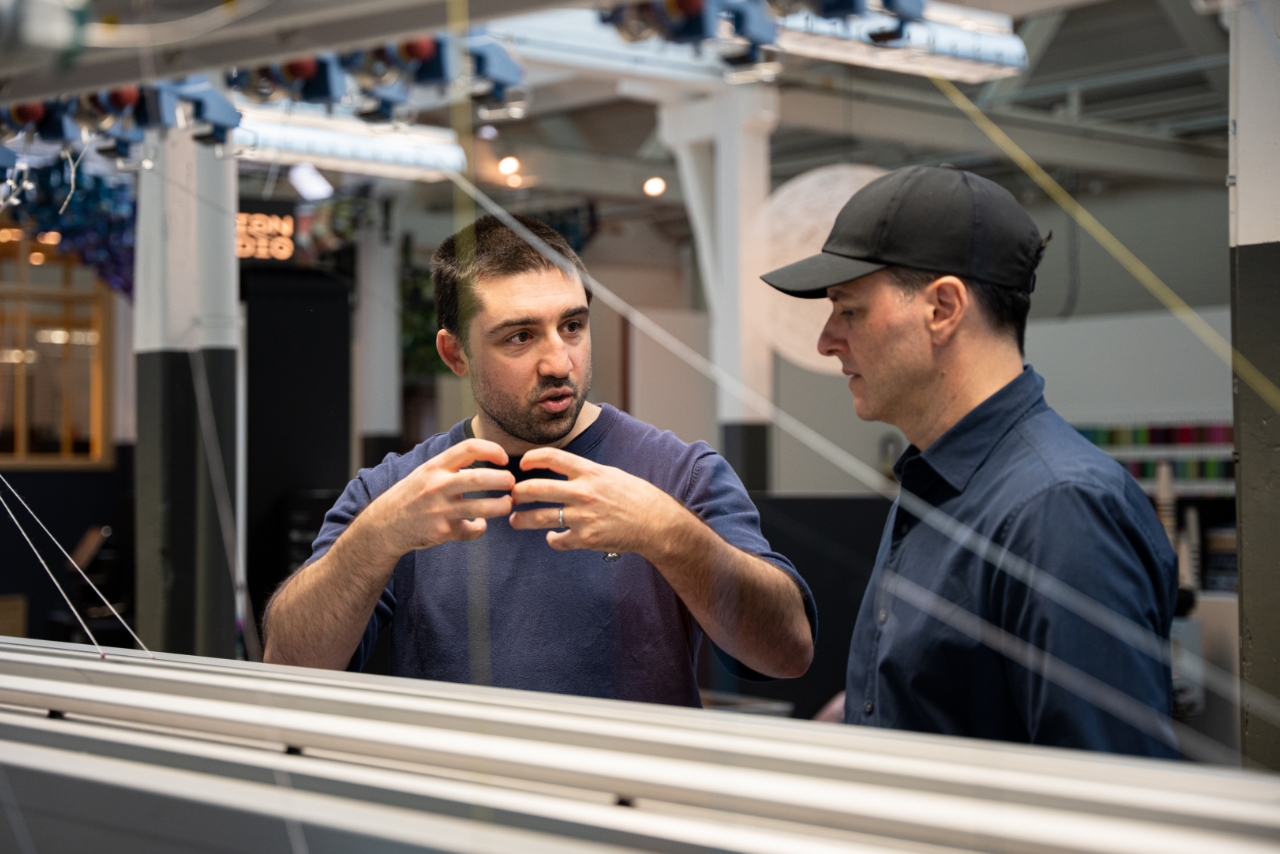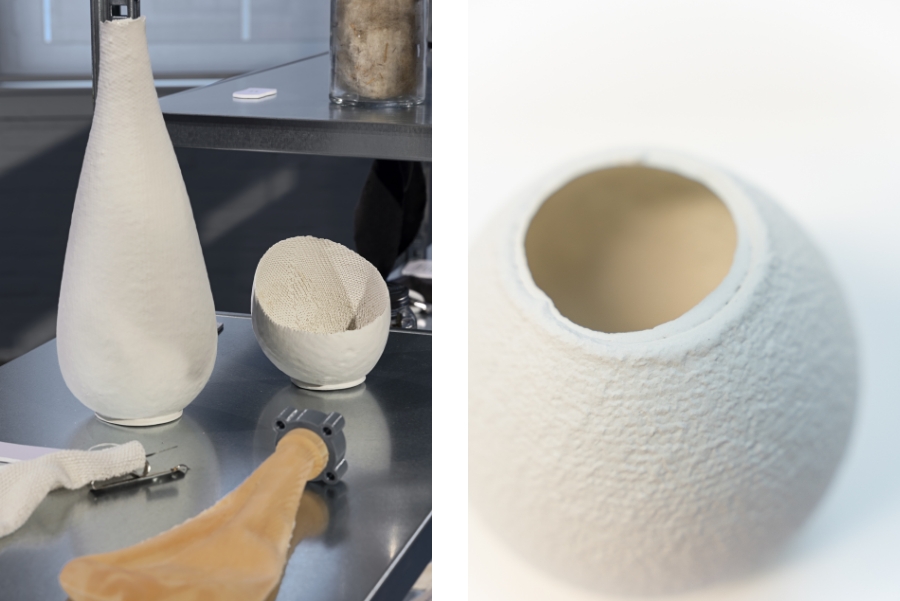Chicago-based industrial designer Brian Anderson came to Brabant to investigate how to make ceramics using a textile mould. The results, developed in collaboration with the Europees Keramisch Werkcentrum (EKWC) and the TextielLab, are currently on display in Secrets of making #3.
“In some ways, it’s like baking a soufflé: it’s expected yet still a relief when you open the kiln and an experimental ceramic form is whole,” says Brian Anderson. For the past few months, he has been commuting back and forth between the TextielLab in Tilburg and the EKWC in nearby Oisterwijk. He is developing a novel approach for producing thin-walled ceramic vases – not using conventional plaster moulds but moulds made from wool and other natural fibres. The fact that an entire object can be knitted with a single thread was his starting point for making the whole manufacturing process more sustainable, using regional raw materials, expertise and facilities. “Gypsum – the main constituent of plaster – is mined or is a by-product of burning coal. For ceramicists, the process is messy and cumbersome, and the material is heavy.” He wanted to find a cleaner, lighter and more local approach based on sustainable agriculture. Textiles presented an interesting opportunity.

Brian Anderson with one of his knitted moulds. Photo: Patty van den Elshout
Open-ended process
The fully fashioned ‘pouches’ that he makes in the TextielLab with product developers Damien Semerdjian and Sarena Huizinga have a much smaller footprint than conventional moulds. But there’s more to it than that. Anderson is fascinated by the crossover between the completely different worlds of textiles and ceramics. The idea first came to him when he was 3D printing plastic moulds at the EKWC and noticed that the structure resembled a woven or knitted fabric. He applied for a second working period at the EKWC and built development time at the TextielLab into his proposal. He says, “There are few places in the world with two non-commercial workplaces like this so close together, where they have so much expertise in guiding experimental, open-ended design projects.”

Product developer Damien Semerdjian and Brian Anderson in the TextielLab. Photo: Patty van den Elshout
Dipping and smearing
As an artist in residence at the EKWC, Anderson is living and working in Oisterwijk for three months. He sleeps mere metres away from the kilns and can often be found hands-deep in clay late into the night. He regularly makes the short trip to the TextielLab where he is iterating knitted forms with the product developers. The film made especially for Secrets of making #3 shows how he uses the samples from Tilburg in Oisterwijk: the pouches are filled with a special kind of balloon or air bladder, which is inflated to pull the loose knit tight. This is followed by dipping, pouring and smearing to ensure the clay permeates the knit. When the clay is sufficiently hard, the balloon is removed and the vase is fired in a kiln at over 1,200 degrees. The yarn burns away in the kiln, but the shape and structure of the knit remains.
Bubbles
“It’s amazing to see those soft knitted pouches become hard and fragile during the creative process,” says Huizinga. “We’ve done numerous tests with wool as well as with linen, cotton, flax and paper yarn. We’re mainly focusing on how to create and transfer different structures in the clay. The tests range from loose to tight, with bubbles and patterns. We’re also experimenting with stretch in the knits.” Huizinga is currently working on a knit that combines stretchy and non-stretchy areas, which produces a kind of quilted effect. All these variations impact the shape and surface of the clay in different ways. “When you wash wool in hot water, you get an extreme transformation from big and loose to dense and fluffy,” says Anderson. “I love that transformation and I also incorporate it into my designs.”
Seven advisors
The experiments then continue in Oisterwijk. Artists live and work in 16 studios at the EKWC and can enlist each other’s help and the help of seven technical advisors. “Here, you can discover in three months what would take you years to find out on your own,” says ceramicist and technical advisor Katrin König. She advises Anderson on what can and can’t be done with different types of clay. “We’ve now adapted the slip – liquid clay – to such an extent that the knit becomes saturated with it, and the structure remains intact after the knit has burned away.” The fact that this structure has so far been more visible on the inside of the vase than on the outside is something the team is still working on. They want to adjust the mould in such a way that a cover is created that can be pulled over the outside of the clay.

The results can be seen in Secrets of making #3 in the TextielMuseum. Photo: Josefina Eikenaar. / Detail of one of the moulds. Photo: Patty van den Elshout
Connecting link
Anderson is the link connecting both institutions. Two specialised worlds communicate with each other through the artist, who, by questioning a standard production process, has brought together two surprising materials. Says König, “It’s a wonderful interdisciplinary process that runs very smoothly. The great thing is that an industrial designer like Brian sees clay completely differently from a ceramicist, and that undoubtedly also applies to a textile designer. I think these completely different approaches to the material are fantastic.”
In his final weeks in Brabant, Anderson wants to further increase the project’s sustainability by working with regional materials: in this case clay from the Maas river and locally grown flax. “As a ceramicist, you’d think twice about working with Maas clay because it’s mainly used to make bricks,” says König. “But someone with a design background might decide to do exactly that.”
“It’s amazing to see those soft knitted pouches become hard and fragile.” – Sarena Huizinga
Washi
Unimpeded by overly specialist technical knowledge of either textiles or ceramics, Anderson has taken large strides towards what he calls “a gypsum-free ceramic ecosystem”. Although his time at the EKWC is running out, his research will continue. “I learned a lot in these unique workplaces in the Netherlands. I’m going to try the same thing with regional raw materials in the US and in Japan. I’d like to start making washi moulds there.”
The results of Brian Anderson’s work can be seen at Secrets of making #3 at the TextielMuseum.